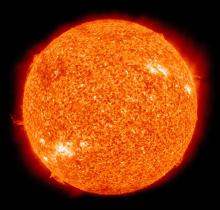Listen to today's episode of StarDate on the web the same day it airs in high-quality streaming audio without any extra ads or announcements. Choose a $8 one-month pass, or listen every day for a year for just $30.
You are here
Selective Viewing
The stars that are visible to the unaided eye aren’t representative of the galaxy as a whole -- far from it. We see many giants and supergiants, for example. Yet those types of stars make up only a tiny fraction of the overall stellar population. Most of the stars in the Milky Way are small and feeble -- so feeble that we can’t see a single one, even though several are among our closest neighbors.
Astronomers call this a selection effect -- some things are easier to see than others. A spiffy European sports car stands out among the usual sedans and SUVs, for example.
For scientists, though, that can be a problem. If astronomers studied only the bright stars -- the equivalent of racy sports cars -- they’d get a completely wrong idea about how stars form, evolve, and die.
Selection effects are a problem in other ways, too.
When astronomers began discovering planets in other star systems, they found almost exclusively one type: giant worlds in close orbits around their stars. The techniques used to find exoplanets work best on those types of worlds.
In the decades since, though, they’ve discovered thousands of planets that are smaller, farther out, or both. Only by studying all of these planets can we get a full picture of the lives of planets and planetary systems.
So astronomers can’t settle for looking at the easy targets. To fully understand the workings of the universe, they need to study the hard ones, too.
Script by Damond Benningfield





